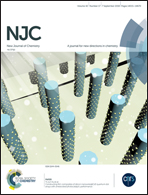Visible light induced degradation of pollutant dyes using a self-assembled graphene oxide–molybdenum oxo-bis(dithiolene) composite†
Abstract
We have described the room temperature synthesis of a graphene oxide–molybdenum oxo-bis(dithiolene) ([Ph4P]2[MoO(S2C2(CN)2)2]) composite (GO–Mo). The ionic and non-covalent interactions between the Mo complex and the GO surface aided the formation of a layered GO–Mo structure, employing GO as a template. GO–Mo has been characterized using electron microscopy (FESEM and TEM), Fourier transform infrared (FTIR) spectroscopy, powder X-ray diffraction (PXRD), and X-ray photoelectron spectroscopy (XPS). GO–Mo showed remarkable activity (>90%) for the degradation of Rhodamine B and Rose Bengal dyes in aqueous solution under visible light irradiation (rate of degradation 0.090 and 0.088 min−1 respectively) without any sacrificial agent and precious metal co-catalysts. The kinetics of the degradation have been followed using UV-Vis spectroscopy. We ascribe the superior photocatalytic efficiency of GO–Mo to its layered structure, which could adsorb the dye on the GO–Mo surface and thus facilitate the electron transfer during photo-irradiation. The catalyst was easily separable post water treatment and could be reused up to six times.



 Please wait while we load your content...
Please wait while we load your content...